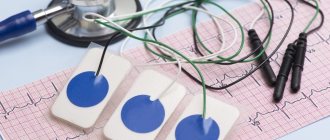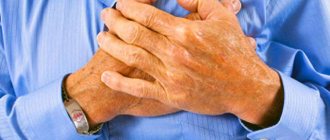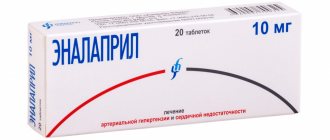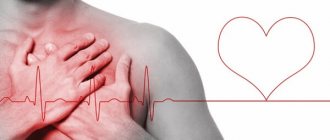Author: MC "Diamed-Tula"
Cardiovascular diseases are dangerous not only because they cause a sudden deterioration in health, but they can also lead to death. WHO has collected statistics according to which more than 17.5 million deaths occur annually due to heart failure. And these terrifying numbers are only growing over time. This state of affairs is surprising, because the sad outcome can be predicted in advance, and trying to prevent it is not difficult. Heart diseases are predictable and reversible. The likelihood of severe consequences can easily be reduced to zero by leading a healthy lifestyle. Of course, for this you will have to give up alcohol and nicotine, move more, and regularly go for routine examinations. This is most important for people at risk: those who suffer from hypertension or arrhythmia should take the most responsible approach to their health.
Causes of heart rhythm disturbances
Let's understand the question of what arrhythmia is. Doctors tend to use this term to refer to any disturbances in the heart rate. This organ may not function properly for two reasons: either changes have occurred in the very structure of the heart muscle, or deviations from the norm are associated with inorganic factors affecting the function of the “pump.”
Do not immediately panic at the slightest change in heart rate. Absolutely healthy people can also be susceptible to spontaneous manifestations of arrhythmia. This condition usually occurs during physical overload, stress, or even during a cold. Although it is dangerous to underestimate the first symptoms: sometimes they indicate an approaching heart attack.
If disruptions in the functioning of the heart were noticed during an examination by a doctor, changes in rhythm may indicate heart failure, coronary artery disease, heart disease, myocarditis, etc. Then the specialist will prescribe the correct treatment and strict monitoring of your health.
But if the doctor does not find cardiac pathologies, the examination should be continued in other directions:
- get checked for diabetes and other endocrine diseases;
- check the balance of magnesium, potassium, sodium;
- find out if there are any problems with blood pressure.
The cause of atrial fibrillation can also be certain pharmacological drugs that a person used before. It also often occurs due to strong emotional experiences, oncology, menopause and head injuries.
Arrhythmia
Treatment for this disease is quite simple if you start this process in a timely manner and do not interrupt it. It is important to undergo examinations on time so that the specialist determines what type of arrhythmias yours belongs to and prescribes the correct complex for eliminating the pathology.
Is arrhythmia treatable?
It is quite possible to eliminate arrhythmia, but it is a pathology that causes side effects if left untreated. Therefore, the earlier the procedures are started, the more effective they will be. Treatment is carried out by cardiologists who prescribe a whole range of actions, including:
- Use of sedative medications. They are usually plant-based. Motherwort, Corvalol, valerian capsules, novopassit help well.
- Medicines that lower blood pressure.
- Beta blockers, membrane stabilizers, potassium channel blockers.
- Useful vitamin complexes (“Riboxin”, “Panangin”, “Magne B6”).
- Physiological procedures are prescribed depending on the patient’s condition. This is a swimming pool, physical therapy, certain training.
- During treatment, a special diet is followed. The doctor describes in detail which foods should be excluded, and, conversely, what to add to the diet. For example, fatty foods, pork, and lard are excluded. You should be careful with tea, coffee, and smoking. Potassium-rich foods are included in the diet. These are dried fruits, honey, banana, black currant. It is also recommended to use parsley, raisins, prunes, and cabbage in your diet. Components rich in calcium and magnesium are also included in the diet.
A set of measures to eliminate the disease includes establishing water balance, giving up alcohol and other bad habits. All this allows us to stabilize the patient’s condition. Of course, in most cases, arrhythmia is eliminated with the help of pharmacological drugs. It is also important to find the root cause of its development.
Cardiac arrhythmia: alternative treatment
Many people are interested in why doctors do not recommend using alternative methods of influencing the body. We are talking about folk recipes. In fact, many experts prescribe such drugs to eliminate pathologies, but not as the main one, but as an additional effect on the body.
Patients, in turn, try to overcome the disease on their own and decide for themselves what they will take. As a rule, this leads to deterioration of health. This is why doctors are skeptical about herbal medicine and traditional healing methods.
Nevertheless, herbal medicine can significantly improve the patient’s condition when used correctly. Some herbs are used to create pharmacological drugs. For example, valerian root, motherwort and the like. They exhibit sedative properties and can relieve stress, nervous tension, and eliminate pain. But the use of herbal medicine is allowed only under the supervision of an experienced specialist. The reason for this is the large number of contraindications for such plants. Valerian root is not always beneficial; it can also cause harm.
We suggest that you familiarize yourself with the list of herbal products that improve the patient’s condition with this disease. But their use is allowed only under the supervision of doctors:
- tinctures of hawthorn, valerian, motherwort;
- tincture of indifference;
- Kirkazon Manchurian;
- evasive peony;
- tincture of calendula;
- Sesame oil;
- infusion of Leuzea safflower;
- chicory.
The list of components that help stop this pathology is very large. But it is worth remembering that only a doctor can help in such a situation. Our clinic helps with arrhythmia, contact us and get rid of the disease. We sincerely wish you good health, but wishes alone are not enough. Take decisive steps towards great health.
How to quickly eliminate pain syndrome
If negative symptoms appear, you should immediately call an ambulance. We recommend calling our center and ordering ambulance services. The car will immediately go to your address, you won’t have to wait long, the team is always ready to instantly respond to a call. But before the arrival of specialists who will provide emergency assistance, you should worry about your health yourself. These actions will help significantly alleviate the condition, and possibly save a life:
- First, medical assistance is called. If you are unable to do this, ask relatives, neighbors, passers-by.
- The heartbeat will return to normal if you gently press your fingers on the eyeballs. This must be done with moderate force, hold for several seconds, and then suddenly release your fingers. Repeat the steps a couple of times.
- Next they induce vomiting. This is done artificially; under no circumstances should you use medications. You should drink a large amount of purified water and induce vomiting by touching the base of your tongue with your fingers. This action often helps save lives.
- The patient should take a deep breath and exhale as much as possible. After this, the nose is pinched, the mouth is closed and the breath is held for several seconds. It is not worth staying in this state for a long time. Sometimes dizziness occurs, so this exercise should be done at the bedside or in a sitting position.
- Ensure air flow, open the window, loosen the collar if the throat is tight with a tie or other clothing.
- Calm down, often unnecessary panic only aggravates the situation. Drink cool water in small sips.
- The use of anti-stress helps very well. This can be any object that is easy to squeeze, bend, but not harm yourself. It distracts from the current situation, removes the feeling of panic and fear.
These techniques are quite simple, everyone can help themselves. As a rule, the condition stabilizes, and many patients refuse hospitalization or specialist help. It is undesirable to make such a decision; it is better to seek help from doctors and find out why this situation arose.
How to notice the first signs of abnormal heart function
At first glance, it seems that it is impossible not to notice the development of cardiac pathology. But in reality, arrhythmia is often asymptomatic. The person continues to feel healthy, and if occasional attacks occur, he attributes them to overwork.
The pathological condition is accompanied by the following manifestations:
- changes in heart rate for no particular reason;
- chest tightness, pain;
- nausea, dizziness;
- loss of consciousness.
People experience these symptoms differently. For some, this is a reason to stay in bed, while others do not pay attention to poor health and risk their lives.
The presence of arrhythmia is easily confirmed by hardware diagnostics. If a doctor suspects a patient has this disease, he may prescribe a chest ultrasound, echocardiography, or electrocardiography.
Arrhythmia comes in different types. Modern medicine knows the following subtypes:
- atrial fibrillation (heart contractions are chaotic);
- paroxysmal tachycardia (pulse is regular, but very frequent - up to 240 beats/min);
- blockade (the pulse temporarily or completely disappears);
- extrasystole (out of sequence of contractions, which leads to an increase or fading of the rhythm);
- respiratory arrhythmia (blood pulses alternate incorrectly, this happens in adolescents or even children).
The most dangerous condition is considered to be erratic heartbeats. They are often accompanied by hoarse breathing, convulsions, and loss of consciousness.
Section materials
November 26, 17:21
The WHO Healthy Cities Conference will be held in St. Petersburg
November 24, 15:34
Barrier to plague. How quarantine checkpoints appeared on the roads to St. Petersburg
November 15, 14:56
In St. Petersburg, hotels are counting losses from the introduction of Covid passports
November 10, 15:34
Scientists have created pills to treat coronavirus
November 10, 13:43
A challenge to our psyche. The number of patients with post-Covid disorders is growing
Causes of cardiac arrhythmia in men or women
There are two common ways in which arrhythmias develop, which can be determined in a particular patient. There may be problems with the initiation of the electrical signal: either the sinus node is firing abnormally, or there is a competing impulse elsewhere in the heart. The second option is problems with the conduction of electrical impulses: connections from the atria to the ventricles are difficult (this is often called heart block).
People with heart disease are especially likely to develop arrhythmias, because heart disease, damage can prevent signals from the atria from reaching the ventricles, or certain areas of the heart may not fire normally.
High blood pressure and an overactive thyroid gland also increase the likelihood of arrhythmias. Alcohol can also cause atrial and ventricular arrhythmias. Some medications, such as decongestants and many prescription drugs, can make the heart susceptible to arrhythmias and should be used with caution in people with heart disease.
There are also hereditary and congenital (present from birth) types of arrhythmia, often resulting in a weak or delayed signal reaching the ventricles. The ventricles can emit their own signal, but it is often less than 40 beats per minute instead of the usual 60-90 beats characteristic of the sinus node. Source: "New Arrhythmia Theory" Clarifies Causes of Arrhythmia. Ermoshkin V.I. Educational bulletin “Consciousness”, 2015. p. 22-30.
Diagnostics
The stethoscope is still a valuable tool for identifying arrhythmias, but there are modern tests that can pinpoint the problem and signs of cardiac arrhythmias in women or men. An electrocardiogram (ECG) displays a graph of the heart's electrical activity using small electrodes attached to the chest. The curve on these graphs shows the type of arrhythmia. Since the arrhythmia may not occur in the hospital, there are portable ECGs that the patient wears at home. Some are turned on continuously over a period of time (called a Holter monitor), while others turn on when a person senses an arrhythmia (called an event monitor or loop recorder).
Certain arrhythmias may be associated with exercise, so patients may be asked to walk on a treadmill or ride an exercise bike while connected to an ECG machine.
Electrophysiological study (EPS) is a more complex test. Thin tubes are inserted into a blood vessel in the leg and directed toward the heart. They hold electrodes that can find muscle tissue that may be causing abnormal electrical activity.
Possible complications and prognosis
First of all, the prognosis of the disease depends on the type of arrhythmia. If the rhythm disturbance is not associated with organic damage to the heart, then it may not cause any particular harm to health. For example, such arrhythmias include supraventricular extrasystoles.
However, there are also very dangerous types of arrhythmias. One of them is atrial fibrillation, which can cause myocardial infarction and heart failure.
Symptoms
When the heart beats faster than normal, it is called tachycardia . Symptoms and signs of arrhythmia include:
- chest discomfort
- cardiopalmus,
- dizziness,
- sometimes fainting.
When the heart beats slower than normal, it is called bradycardia . It can cause fatigue, dizziness, lightheadedness and fainting as it usually causes low blood pressure.
Almost everyone's heart will flutter from time to time, and it usually doesn't mean anything. More often, symptoms of cardiac arrhythmia occur in men and treatment is not always necessary. But if a person has chest pain, feels weak, or notices that the pulse is irregular, either very fast or very slow for a long period, it is time to see a doctor. Source: Insider's View Focus on the Arrhythmia Patient. Boqueria O.L. Annals of Arrhythmology, 2014. p. 196-199.
Symptoms of this disease may not appear. Arrhythmia can be detected by a specialist during a routine clinical examination: before any of its signs appear. But predominantly, heart rhythm disturbances are characterized by the following symptoms:
- pain in the chest;
- increased feeling of heartbeat;
- accelerated heartbeat;
- slow heartbeat;
- dyspnea;
- loss of consciousness or fainting.
In most cases, in a person who has a certain type of arrhythmia, such arrhythmia occurs repeatedly.
Some types of arrhythmias are initially asymptomatic or with few symptoms. Other types of arrhythmias, on the contrary, manifest themselves in pronounced symptoms, but do not have serious consequences. Typically, the nature and severity of the underlying heart disease that causes the arrhythmia are more important than the arrhythmia itself.








